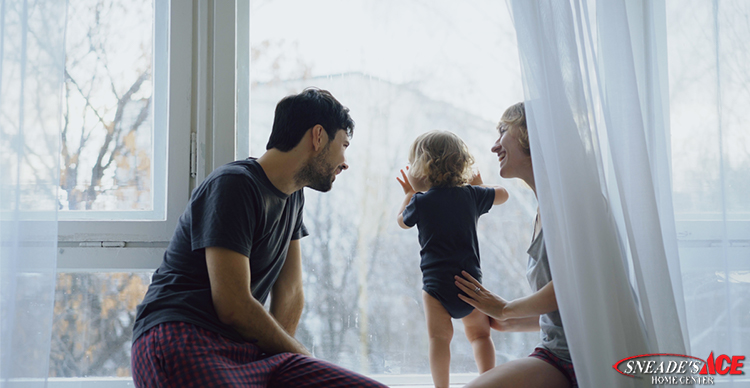Winter-Proof Your House for Energy Efficiency
As the weather gets cooler and the grey skies of winter grow near, many homeowners worry about their winter heat bill. How much will it cost this year? Will they be able to afford it? What can they do to make their home more energy efficient for the winter? Turns out there are numerous things you can do to keep that bill low, and the best news is that most of them are free or low cost. Let’s take a look at what’s recommended by the folks at Sneade’s Ace Home Center for winter energy efficiency this season:
Block out drafts with storm doors and windows and draft guards
If you don’t have one, roll up a thick towel or blanket and place it across the bottom of the door to keep chilly drafts at bay. The draft-sealing and air flow-reducing strength of storm windows and doors can improve your household energy efficiency by almost 50%. Got some in the attic? It’s worth your while to bring them down. You can also try for tax credits up to $200 for new energy-efficient skylights and windows and $500 for doors. Look for Energy-star certified models whenever available.
Lower your thermostat
When you leave the house, turn the thermostat down. We turn ours down at night as well, since we’ll be cozy under the blankets anyway. Lowering the thermostat by as little as 10-15 degrees when you go to work, sleep, or plan to be out for a while can reduce your bills by up to 10% annually.
Turn down your water heater
Everybody loves a nice hot shower and good, hot water for washing dishes. But did you know your hot water heater has to continuously reheat to keep the water that temperature at all times? With most hot water heaters set at 140 degrees Fahrenheit, this can get pricey indeed. Lower it to 120 degrees instead – or opt for a solar water heater to get in on another tax credit here.
Swap out furnace filters every month – or clean them
This helps maintain clean air and low bills, as dirty ones inhibit airflow and increase energy use. Also, consider a permanent electrostatic or HEPA filter, as they’re more efficient at targeting debris (up to 88% of it, to be precise), bacteria, etc.
Need a new furnace entirely? You can get a tax credit for that, too – check here.
Apply window insulation film
This can prevent drafts and keep your heat inside where it belongs. Check out one way to apply it here – and do pay attention to the temperature outside. Some insulation film won’t adhere if it’s lower than 55 degrees out, so you’ll want to do this before it gets too cold.
(Also, depending upon the brand you buy, you’ll probably need weatherstripping to do a thorough job, as well as double-sided tape, and a hairdryer).
Weatherstrip doors and windows
Keep some of the weatherstripping after you’re finished applying the insulation film – or just use it instead. It can work by itself around windows and doors to seal out drafts as well. And it’s cheap!
Use a chimney balloon
Lots of energy flows out and cold air can also flow back in through your chimney flue. Stick a chimney balloon in there to stop it both ways (Just make sure you remember to remove it before starting a fire in the fireplace!). Here’s a quick how-to – and also please remember to put on your safety goggles before starting.
While these are the top energy-saving things you can do to winterize your home, they aren’t all you can do. There are many other actions recommended by energy-savvy homeowners, including:
- Installing lower flow shower heads (saves money not only on water but also energy, as it takes energy to heat much of the water)
- Run ceiling fans in reverse (This actually warms the home, where running them the other way cools it. You can switch many ceiling fans to counter-clockwise rotation. Check it out here)
- Pack fiberglass insulation in attics, around basement doors, and around the edges of window air conditioning units
- Set up an annual check of your heating system by professionals
- Clear your gutters so water can flow freely, preventing backups and icicle formation
- Consider investing in an energy monitor to evaluate your home energy usage and predict your likely bills
- Caulk holes or gaps in any exterior siding, doors, or walls
- Insulate your pipes to maximize efficiency and prevent their freezing by covering them with pre-slit pipe foam
- Have your home’s ductwork professionally evaluated to ensure they’re properly sealed
Any questions? Be sure to stop by one of our Sneade’s Ace Home Center locations in Owings or Lusby Maryland. Or give us a call at 410-257-2963 (Owings) or 410-326-3222 (Lusby). We’ll help you get your winter energy efficiency sorted out!

